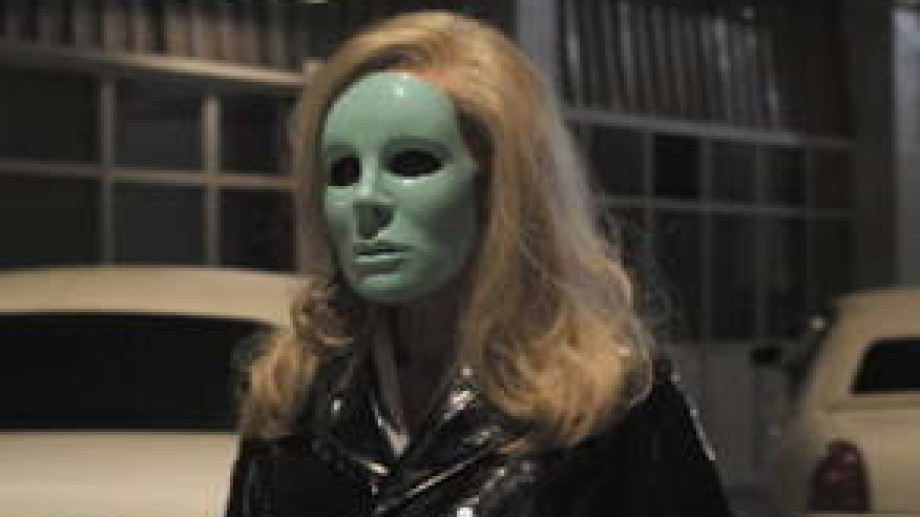
In Leos Carax’s Holy Motors, Denis Lavant plays Monsieur Oscar, a man chauffeured around in a white limo to a series of “appointments” in which he takes on different roles, dressed in various elaborate costumes, over the course of an evening in Paris. The film makes frequent nods to film genres—films noir, sci-fi, the movie-musical—and comments on the never-ending performance of everyday life. However, Lavant is not the only manifestation of artifice in the film. While Holy Motors certainly is “The Denis Lavant Show,” his performance is punctuated by the presence of his three “leading ladies”: Eva Mendes as a fashion model, Kylie Minogue as a fellow performer, and Édith Scob as Oscar's limo driver.
Mendes' Kay M propels the film toward a critique of our obsession with all things physical. In a ridiculous photo shoot that could be straight out of America's Next Top Model, Kay M stands in the middle of the Père-Lachaise cemetery, draped in silk. As he snaps away, the photographer keeps exclaiming: “Beauty! Beauty!” He is quickly distracted, however, when he notices Monsieur Oscar as “Monsieur Merde,” a gibberish-spewing dweller of the sewer system. He starts photographing him instead, now exclaiming: “So weird! So weird!” In trying to get Merde to join Kay M in a photo, an assistant asks: “Do you know Diane Arbus, for example?” Oscar-as-Merde promptly bites off her fingers, and abducts Kay M, carrying her off into the sewers.
Mendes was cast for a reason. She is not only an actress, but a national spokeswoman for Revlon cosmetics and constantly on the arm of “Hollywood hottie” Ryan Gosling. She is well known not only for her acting, but also for her physicality and public image. Rather than sexualizing her (as Mendes, herself, certainly is in the media) Oscar-as-Merde covers her up, instead stripping himself down and covering himself with rose petals, à la American Beauty. Clearly referential of Mendes’ Hollywood presence outside of the film, Carax comments here on how beauty is perceived by the public. The assistant mentions Diane Arbus because she was famous for juxtaposing beauty and hideousness, both of which are gawked at in different ways.

Kylie Minogue’s character, Jean, on the other hand, is present to highlight the bizarrely formulaic nature of film. She and Oscar have a chance encounter as their limos collide; they recognize each other from a long time ago, when perhaps they looked like “themselves.” With only half an hour to spare between jobs, Jean takes Oscar to a quasi-demolished, empty department store, where she bursts into a maudlin song about when “they were who they were.” They part and Oscar walks out onto the street, to notice that she and her partner have jumped out the department store window.
This sequence in the film underscores the easy happenstance of the “chance encounter” but, more importantly, the extreme artifice of the movie musical. Only through the magic of a musical do people burst into song when they are suicidal and waxing nostalgic. Unlike with Mendez, Minogue's pop superstardom is referenced directly earlier in the film, when an apartment party is blasting “Can’t Get You Out Of My Head.” The song is also a minor character's ringtone. These references precede Minogue actually singing, drawing particular attention to her celebrity outside the film and highlighting the film's fiction. Minogue's presence in the film supplements Carax’s overall “thesis” of filmic performativity, role-playing and artifice.

Perhaps the most iconic presence belongs to Edith Scob as Céline. Scob starred in Georges Franju’s Eyes Without A Face (1960), in which she plays Christiane, a young woman whose face is destroyed in a car accident and, as a result, must wear an expressionless mask. Only her eyes are visible to evoke any emotion—and they evoke a lot. Eyes Without A Face is referenced many times in Holy Motors. Two notable cases are a tracking shot from within the limo driving through the forest and one of the films final scenes, in which Scob parks the limo at the service station (called “Holy Motors”) and puts on a mask as she leaves for home.
This replicated imagery of the mask is a valuable metaphor for performance in the film. Oscar, for instance, doesn’t truly have a “face”—he dons prosthetics and makeup to perform a variety of different roles throughout the film. The mask also gives a universality to Céline's role in the film; she could, quite literally, be anyone on their way home from work. At the same time it brings to mind the platitude that we all wear a mask, in a figurative sense. Metaphors aside, Scob's very presence along with the mask is a simple, fourth wall-breaking nod to Eyes Without A Face. The film is iconic, especially of the surrealist-inspired cinema with which Holy Motors is so closely aligned.
While Monsieur Oscar is the central figure in Carax’s vision of shape-shifting, identity, and performativity, the characters played by Mendes, Minogue, and Scob all drive the film toward a deeper commentary and provide Carax with an opportunity to wink at their star personae outside the film. They are definitely more than featured players on “The Denis Lavant Show.”
Caitlin Hughes is a member of the NYFF Critics Academy program. You can follow her on Twitter at @C_B_Hughes.
Holy Motors is now playing daily at the Film Society of Lincoln Center!



